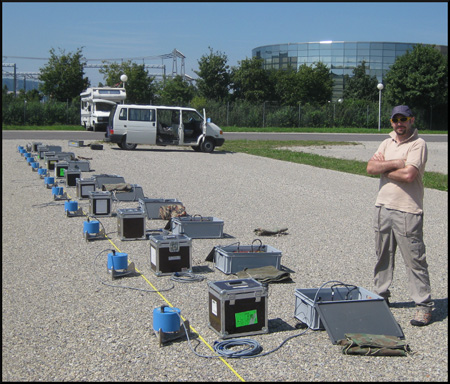Site characterization research
Bergamo., P., Hammer, C. and Fäh, D. (2021). Correspondence between Site Amplification and Topographical, Geological Parameters: Collation of Data from Swiss and Japanese Stations, and Neural Networks‐Based Prediction of Local Response. Bulletin of the Seismological Society of America 112 (2). Link doi: 10.1785/0120210225
Michel, C., Fäh, D., Edwards, B., & Cauzzi, C. (2017). Site amplification at the city scale in Basel (Switzerland) from geophysical site characterization and spectral modelling of recorded earthquakes. Physics and Chemistry of the Earth, Parts A/B/C 98, 27-40. doi: 10.1016/j.pce.2016.07.005
Poggi, V., Burjanek, J., Michel, C., & Fäh, D. (2017). Seismic site-response characterization of high-velocity sites using advanced geophysical techniques: application to the NAGRA-Net. Geophysical Journal International 210(2), 645–659. doi: 10.1093/gji/ggx192
Michel, C., Edwards, B., Poggi, V., Burjanek, J., Roten, D., Cauzzi, C. and Fäh, D. (2014). Assessment of site effects in Alpine regions through systematic site characterization of seismic stations. Bulletin of the Seismological Society of America 104(6), 2809-2826. doi: 10.1785/0120140097
Burjánek, J., Edwards, B. and Fäh, D. (2014). Empirical evidence of local seismic effects at sites with pronounced topography: a systematic approach. Geophysical Journal International 197(1), 608-619. doi: 10.1093/gji/ggu014
Edwards, B., Michel, C., Poggi, V. and Fäh D. (2013). Determination of Site Amplification from Regional Seismicity: Application to the Swiss National Seismic Networks. Seismological Research Letters 84(4), 611-621. doi: 10.1785/0220120176
Hobiger, M., Bergamo, P., Imperatori, W., Panzera, F., Lontsi, M.S., Perron, V., Michel, C., Burjánek, J., Fäh, D. (2021). Site Characterization of Swiss Strong‐Motion Stations: The Benefit of Advanced Processing Algorithms. Bulletin of the Seismological Society of America 111 (4), 1713-1739. Link doi: 10.1785/0120200316
Panzera, F., Alber, J., Imperatori, W., Bergamo, P., Fäh, D. (2022). Reconstructing a 3D model from geophysical data for local amplification modelling: The study case of the upper Rhone valley, Switzerland.. Soil Dynamics and Earthquake Engineering 155. Link doi: 10.1016/j.soildyn.2022.107163
Glueer, F., Häusler, M., Gischig, V., Fäh, D. (2021). Coseismic Stability Assessment of a Damaged Underground Ammunition Storage Chamber Through Ambient Vibration Recordings and Numerical Modelling. Frontiers of Earth Science 9 (1159), 773155. Link doi: 10.3389/feart.2021.773155
Shynkarenko, A., Lontsi, A.M., Kremer, K., Bergamo, P., Hobiger, M., Hallo, M., Fäh D. (2021). Investigating the subsurface in a shallow water environment using array and single-station ambient vibration techniques. Geophysical Journal International 227 (3), 1857-1878. Link doi: 10.1093/gji/ggab314
Lontsi, A.M., Shynkarenko, A., Kremer, K., Hobiger, M., Bergamo, P., Fabbri, S.C., Anselmetti, F.S. and Fäh, D. (2021). A robust workflow for acquiring and preprocessing ambient vibration data from small aperture ocean bottom seismometer arrays to extract Scholte and Love waves phase-velocity dispersion curves. Pure and Applied Geophysics. Link doi: 10.1007/s00024-021-02923-8
Häusler, M., Michel, C., Burjánek, J., and Fäh, D. (2021). Monitoring the Preonzo rock slope instability using resonance mode analysis. J. Geophys. Res. Earth Surf. e2020JF005709. Link doi: 10.1029/2020JF005709
Hallo, M., Imperatori, W., Panzera, F., Fäh, D. (2021). Joint multizonal transdimensional Bayesian inversion of surface wave dispersion and ellipticity curves for local near-surface imaging. Geophysical Journal International 226 (1), 627-659. doi: https://doi.org/10.1093/gji/ggab116
Bergamo, P., Hammer, C., and Fäh, D. (2021). On the Relation between Empirical Amplification and Proxies Measured at Swiss and Japanese Stations: Systematic Regression Analysis and Neural Network Prediction of Amplification. Bulletin of the Seismological Society of America 111 (1), 101-120. Link doi: 10.1785/0120200228
Chieppa, D., Hobiger, M.& D. Fäh (2020). Ambient Vibration Analysis on Large Scale Arrays When Lateral Variations Occur in the Subsurface: A Study Case in Switzerland. Pure and Applied Geophysics 177, 4247–4269. Link doi: 10.1007/s00024-020-02516-x
Chieppa, D., Hobiger, M. & D. Fäh (2020). Ambient vibration analysis on seismic arrays to investigate the properties of the upper crust: an example from Herdern in Switzerland. Geophysical Journal International ggaa182. doi: 10.1093/gji/ggaa182
Häusler, M Michel, C. Burjanek, J. & D. Fäh (2019). Fracture Network Imaging on Rock Slope Instabilities Using Resonance Mode Analysis. Geophysical Research Letters Volume 46, Issue 12, 6497-6506. doi: 10.1029/2019GL083201
Kleinbrod, U., Burjanek, J., Fäh, D (2019). Ambient vibration classification of unstable rock slopes: A systematic approach. Engineering Geology Volume 249, 198-217.
Maranò, S., Hobiger, M., Bergamo, P. & D. Fäh (2017). Analysis of Rayleigh waves with circular wavefront: a maximum likelihood approach. Geophysical Journal International 210, 3, 1570–1580. doi: https://doi.org/10.1093/gji/ggx225
Burjánek, J., Gischig, V., Moore, J.R. and Fäh, D. (2018). Ambient vibration characterization and monitoring of a rock slope close to collapse. Geophys. J. Int. 212, 297–310. Link doi: 10.1093/gji/ggx424
Maranò, S., Hobiger, M. & D. Fäh (2017). Retrieval of Rayleigh Wave Ellipticity from Ambient Vibration Recordings. Geophys. J. Int.. Link doi: 10.1093/gji/ggx014
Kleinbrod, U., Burjánek, J., Fäh, D. (2017). On the seismic response of instable rock slopes based on ambient vibration recordings. Earth. Planets and Space 69: 126. doi: 10.1186/s40623-017-0712-5
Kleinbrod, U., Huggentobler, M., Burjánek, J., Aman, F., Fäh, D. (2017). A comparative study on seismic response of two unstable rock slopes within same tectonic setting but different activity level. Geophys. J. Int. 211, 3, 1428-1448. Link doi: 10.1093/gji/ggx376
Panzera, F., Bergamo, P. & Fäh, D. (2020). Reference soil condition for intensity prediction equations derived from seismological and geophysical data at seismic stations. Journal of Seismology 25 (1). Link doi: 10.1007/s10950-020-09962-z
